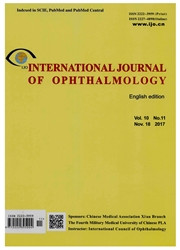

 中文摘要:
中文摘要:
AIM:To experimentally compare the external sclerostomy produced using a femtosecond laser with that made by a surgical knife and to evaluate the healing patterns,efficacy and technical advantages of femtosecond laser sclerostomy.· METHODS:In a prospective randomized,controlled,masked-observer study,10 pigmented rabbits underwent external sclerostomy with a femtosecond laser in the right eye;10 additional rabbits underwent sclerostomy with a surgical superblade in the right eye.Clinical characteristics,which included bleb morphology and intraocular pressure,were recorded for 1 month after surgery.Six additional rabbits underwent external femtosecond laser sclerostomy in the right eye and mechanical sclerostomy in the left eye and were killed at day 14 after surgery.Histologic staining,immunohistochemistry and scanning electron microscopy were subsequently performed to assess the morphology of the filtering fistula.The titanium-sapphire femtosecond laboratory laser was operating at a repetition rate of 1 kHz,0.4 mJ pulse energy,a central wavelength of 800nm and a pulse duration of 50 femtoseconds.Mann-Whitney and Kaplan-Meier tests were used for statistical analysis.· RESULTS:Successful complete sclerostomy was achieved in each laser-treated eye which was hit only once by the laser.The laser treated time was approximately 15s-16s.In the laser-treated group(n =16),2 eyes(12%) developed mild hyphema at the site of entry and 8 eyes(50%) showed transient edema in the corneal periphery adjacent to the laser impact zone.The differences between the groups in duration of function blebs and pressure reduction were statistically significant(P =0.025 and 0.016,respectively).The success rate of the laser-treated group was significantly higher than the knife group(P =0.005).Histologically,the subconjunctival connective tissue was loosely arranged with partially patent sclerostomy in the laser-treated eyes at postoperative day 14.This contrasted with the completely scarred sclerostomy tract in the knife group.The mean numbers
 英文摘要:
英文摘要:
AIM: To experimentally compare the external sclerostomy produced using a femtosecond laser with that made by a surgical knife and to evaluate the healing patterns, efficacy and technical advantages of femtosecond laser sclerostomy. METHODS: In a prospective randomized, controlled, masked-observer study, 10 pigmented rabbits underwent external sclerostomy with a femtosecond laser in the right eye; 10 additional rabbits underwent sclerostomy with a surgical superblade in the right eye. Clinical characteristics, which included bleb morphology and intraocular pressure, were recorded for 1 month after surgery. Six additional rabbits underwent external femtosecond laser sclerostomy in the right eye and mechanical sclerostomy in the left eye and were killed at day 14 after surgery. Histologic staining, immunohistochemistry and scanning electron microscopy were subsequently performed to assess the morphology of the filtering fistula. The titanium-sapphire femtosecond laboratory laser was operating at a repetition rate of 1 kHz, 0.4 mJ pulse energy, a central wavelength of 800nm and a pulse duration of 50 femtoseconds. Mann-Whitney and Kaplan-Meier tests were used for statistical analysis. RESULTS: Successful complete sclerostomy was achieved in each laser-treated eye which was hit only once by the laser. The laser treated time was approximately 15s-16s. In the laser-treated group (n =16), 2 eyes (12%) developed mild hyphema at the site of entry and 8 eyes (50%) showed transient edema in the corneal periphery adjacent to the laser impact zone. The differences between the groups in duration of function blebs and pressure reduction were statistically significant (P=0.025 and 0.016, respectively). The success rate of the laser-treated group was significantly higher than the knife group (P=0.005). Histologically, the subconjunctival connective tissue was loosely arranged with partially patent sclerostomy in the laser-treated eyes at postoperative day 14. This contrasted with the completely scarred sclerostomy tract in the kni
 同期刊论文项目
同期刊论文项目
 同项目期刊论文
同项目期刊论文
 Experimental study on supercontinuum generation in zero-dispersion wavelength decreasing photonic cr
Experimental study on supercontinuum generation in zero-dispersion wavelength decreasing photonic cr Effects of structure parameters on the dispersion properties of dispersion compensation photonic cry
Effects of structure parameters on the dispersion properties of dispersion compensation photonic cry 期刊信息
期刊信息
